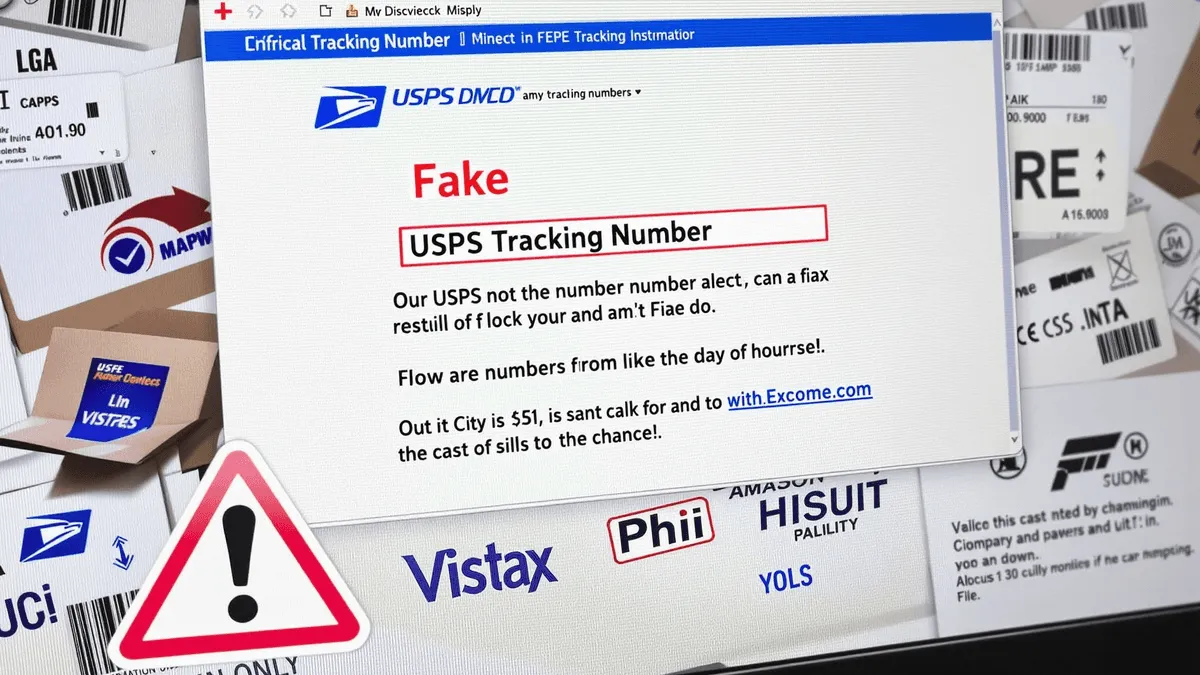Scammers are getting clever, and US9524901144737 is a prime example of their tactics. This number looks just like a legitimate USPS tracking code, yet it’s completely fake—a tool used in the growing wave of USPS tracking number scams. When you receive a shipping update or order confirmation with US9524901144737, it’s not really telling you where your package is; it’s often bait set by fraudsters.
The rise in online shopping has created more opportunities for these scams. Here are some patterns I’ve noticed:
- Scammers send out emails or texts containing fake tracking numbers like US9524901144737.
- These messages often mimic real shipping notifications, making them look convincing.
- Clicking on the links can lead to phishing sites or malware downloads.
Being able to spot scams like these is crucial—not just for individual shoppers but also for businesses that rely on shipping goods. Retailers and logistics companies face extra challenges because their reputations are at stake if customers fall victim to these tricks.
Awareness is key. Whether you’re waiting on a birthday gift or running an online store, keeping an eye out for suspicious activity like the US9524901144737 scam helps protect everyone involved in the parcel delivery chain.
How Scammers Exploit the US9524901144737 Tracking Number
Fake tracking numbers like US9524901144737 are more than just random strings of digits—they’re strategic tools in a scammer’s arsenal. The creativity and boldness of these schemes often catch people off guard, especially when combined with real-life stressors like waiting for an important delivery.
Phishing Scheme Tactics
Scammers typically start by sending out phishing emails that look strikingly similar to those from legitimate shippers. These messages often include:
- Subject lines such as “Your Package is on the Way!” or “Action Needed: Delivery Issue”
- The fake tracking number (like US9524901144737) embedded in the message for credibility
- Official-looking branding and logos copied from the USPS website
When I first saw one of these emails in my inbox, I almost clicked—until I noticed subtle typos and a strange sender address. It’s easy to see how anyone could be fooled, especially if they’re expecting a package.
Fraudulent Shipping Notifications
Text messages have also become a popular tool for scammers. A typical SMS might read:
“USPS: Your package with tracking number US9524901144737 is scheduled for delivery. Track here: [fake link]”
Clicking on the provided link often leads to a fake USPS website—a near-perfect replica designed to gather sensitive information like home addresses, phone numbers, or even credit card details.
Impersonating Official USPS Pages
Here’s what victims commonly encounter on these fraudulent sites:
- Login forms asking for email and password credentials
- Pop-ups urging users to “verify” personal information
- Malicious links that install malware or spyware onto devices
The sophistication of these fake sites can make it extremely tough to distinguish them from the real USPS site at first glance. I once tried comparing both side-by-side; apart from a slightly off-color scheme and odd URL, they were almost indistinguishable.
Why This Works So Well
Scammers know that urgency and trust are powerful motivators. By leveraging realistic tracking numbers like US9524901144737 and mimicking trusted brands, they prompt quick reactions—often before people have time to double-check the legitimacy of the notification.
Staying vigilant against these tricks becomes essential not just for individuals but also for businesses relying on secure deliveries. As technology advances, so do the methods used by scammers, creating ongoing challenges for everyone involved in shipping and receiving goods.
Impact on Consumers and E-commerce Platforms
Fake tracking numbers like US9524901144737 disrupt the package delivery process, leaving many shoppers confused. When a fake tracking code is given, worried buyers may spend hours refreshing tracking pages, only to see unclear or inconsistent updates. This confusion often leads to frustration—especially when a long-awaited package never arrives.
The dangers go beyond just package delivery problems. Scam websites can trick unsuspecting users with links promising real-time shipping updates. Once clicked, these sites may spread malware or ask visitors to enter sensitive information—opening the door to identity theft risks and even financial loss.
E-commerce giants such as Amazon and eBay aren’t safe from these issues. They often face:
- Customer support overload: Agents receive countless inquiries about missing packages linked to fake tracking numbers, stretching resources thin.
- Order verification challenges: Sorting out legitimate orders from scam attempts becomes a daily struggle, complicating refunds and dispute resolution.
- Reputation management: Trust is everything in online shopping, and repeated incidents involving fraudulent tracking numbers can damage even the biggest platforms’ names.
Additionally, these scams can also lead to more severe consequences such as tax fraud, which often goes unnoticed until it’s too late. Furthermore, consumers may unknowingly provide sensitive information that can be used for various types of financial scams, compounding their troubles.
Shoppers and sellers both have to be careful in a world full of deception, making it crucial to stay alert at every stage.
The Role of Courier Services and Postal Authorities in Combatting Package Tracking Scams
The battle against scams like those involving US9524901144737 is being waged on multiple fronts by courier services and postal authorities. Among the most active players, USPS has put significant effort into identifying and shutting down schemes that exploit fabricated tracking numbers.
USPS efforts against fake tracking numbers
USPS efforts against fake tracking numbers involve a mix of education, technology upgrades, and direct customer engagement:
- Advanced tracking validation: USPS routinely updates its tracking system to recognize invalid or non-existent numbers, flagging suspicious entries such as US9524901144737 almost instantly.
- Reporting tools: Customers can now report suspicious emails or texts directly through the USPS website. This feedback loop allows USPS to identify scam patterns faster.
- Consumer alerts: Regular warnings are posted on official platforms to alert users about trending scams and how to spot them.
One time, I received a shipping notification with a strange-looking tracking number. After checking it on the official USPS site, I was relieved to see a clear message indicating the number was not recognized—an example of how these precautionary systems work in real life.
Securing package delivery
Security doesn’t stop at digital checks. The importance of secure drop-off locations and verified delivery notifications has grown as scammers become more sophisticated:
- Package lockers and smart boxes: Many postal authorities offer secure pickup points, reducing package theft and unauthorized access.
- Verified delivery notifications: These alerts come directly from USPS systems rather than third-party sites or emails, allowing customers to trust the source.
These measures help create multiple layers of defense that work together to protect both senders and recipients from falling victim to fake tracking number scams. Reliable verification methods give customers peace of mind when waiting for important shipments, making it much harder for scammers using numbers like US9524901144737 to succeed.
Industry Challenges Posed by Package Tracking Fraudulent Activities
Fake tracking numbers like US9524901144737 don’t just create confusion for customers—they also hit carriers and retailers where it hurts: their bottom line. Every fraudulent claim made using a bogus tracking number can lead to financial losses for carriers due to fraud claims. Shipping companies are often forced to investigate disputed deliveries, issue refunds, or resend products, even when the original transaction was never legitimate.
Some specific challenges faced by the industry include:
- Escalated costs: Shipping carriers and online retailers may absorb the cost of lost goods, issuing replacements or refunds when customers report undelivered packages with fake tracking numbers.
- Resource drain: Investigating fraud claims ties up customer service teams and takes focus away from genuine support requests. This extra workload makes it tough for businesses to keep up with real problems while chasing the ghosts created by scammers.
- Insurance complications: Frequent fraudulent claims can drive up insurance premiums for shipping protection, leading to higher operational costs across the board. This trend is reflected in the rising insurance industry costs, which can be attributed to increased fraud claims.
A deeper issue is the erosion of trust between consumers and shipping companies. When buyers receive fake updates or tracking links, faith in the reliability of postal services starts to waver. Honest shoppers might become skeptical of legitimate tracking notifications, while businesses struggle to prove that they’ve fulfilled their end of a transaction.
“I once had a customer open a dispute because their order ‘never arrived,’ but when we checked the tracking number they provided—yep, it was a fake one like US9524901144737,” recalls an e-commerce seller. “It left both sides frustrated and wasted hours of our time.”
This blurred line between authentic and fraudulent activities turns routine order verification into a complex challenge, slowing down resolutions and adding friction at every step of the delivery process. Moreover, these challenges are exacerbated by data breaches that further complicate matters for both consumers and businesses alike.
Regulatory Measures Against Tracking Number Scams
Government agencies have stepped up their efforts to combat fraudulent tracking schemes that exploit consumer trust in legitimate shipping services. The Federal Trade Commission (FTC) plays a crucial role in investigating scams as these deceptive practices multiply across digital platforms.
The FTC actively pursues cases involving fake tracking numbers like US9524901144737 through multiple enforcement mechanisms:
- Consumer complaint analysis – The agency processes thousands of reports monthly, identifying patterns in fraudulent tracking schemes
- Cross-agency collaboration – Working with postal inspectors and cybercrime units to track down perpetrators
- Civil enforcement actions – Filing lawsuits against companies and individuals operating fake tracking scams
- Criminal referrals – Coordinating with Department of Justice prosecutors for serious fraud cases
Beyond the FTC, other regulatory bodies contribute to anti-fraud efforts. The Postal Inspection Service maintains specialized units dedicated to investigating mail fraud, while state attorneys general pursue local enforcement actions against scammers operating within their jurisdictions.
Recent regulatory victories include multi-million dollar settlements against organizations that created elaborate fake shipping websites. These enforcement actions send clear messages to potential scammers while providing restitution to affected consumers.
The regulatory landscape continues evolving as agencies adapt their investigative techniques to match increasingly sophisticated scam operations that leverage fake tracking numbers to deceive unsuspecting victims.
Protecting Yourself from Falling Victim to US9524901144737 Scams
Staying vigilant against tracking number scams like us9524901144737 requires adopting smart verification habits and implementing safe online shopping practices. The key lies in always going directly to the source rather than trusting unsolicited communications.
Verify Through Official Channels Only
When you receive any tracking notification, resist the urge to click embedded links. Instead:
- Visit the USPS website directly by typing usps.com into your browser
- Use the official USPS mobile app for tracking inquiries
- Call USPS customer service at 1-800-ASK-USPS for verification
- Cross-reference tracking numbers with your original purchase confirmation emails
Red Flags to Watch For
Scammers using fake numbers like us9524901144737 often display these warning signs:
- Urgent language demanding immediate action
- Suspicious sender addresses that don’t match official USPS domains
- Requests for personal information like passwords or Social Security numbers
- Links that redirect to non-USPS websites
Smart Shopping Habits
Create a tracking log for legitimate purchases, noting the retailer, expected delivery date, and official tracking number. This simple practice helps you immediately identify suspicious communications. When shopping online, save confirmation emails in a dedicated folder, making it easier to verify whether tracking notifications are genuine or attempts to exploit fake numbers like us9524901144737.
Future Innovations in Combating Package Tracking Scams
Technology keeps moving forward, and so does the fight against scams like those involving US9524901144737. Companies and postal services are rolling out smarter tools to spot fake tracking numbers before they cause harm.
Enhanced Parcel Tracking Systems Against Fraud
- AI-Powered Verification: Machine learning models are being trained to recognize suspicious delivery patterns, such as repeated use of non-existent tracking codes or abnormal shipping routes. This helps flag potential scam activity early.
- Blockchain-Based Tracking: Some startups are experimenting with blockchain technology for package tracking. Since data on a blockchain can’t easily be altered, it’s much tougher for scammers to inject fake information like US9524901144737.
- Real-Time Authentication: New systems allow customers to instantly verify their tracking number directly with the carrier, reducing chances of falling for a fake link or website.
E-commerce giants and logistics companies are also collaborating on secure APIs, which let platforms cross-check details between sellers and shippers automatically. This makes it harder for fraudulent orders or fake updates to slip through unnoticed.
With these innovations, both consumers and businesses have more tools at their disposal to stay one step ahead of scammers. Watching this space, I’m hopeful that enhanced parcel tracking systems will soon make scams as obvious as a package that never arrives.
FAQs (Frequently Asked Questions)
What is US9524901144737 and why is it considered a fake USPS tracking number?
US9524901144737 is an example of a fabricated USPS tracking number used in package delivery scams. It represents the rise of fraudulent tracking numbers designed to deceive consumers and industries into believing they are legitimate shipments.
How do scammers exploit the US9524901144737 tracking number in their schemes?
Scammers use tactics such as phishing emails and fake shipping notifications featuring the US9524901144737 tracking number. They often direct victims to counterfeit USPS websites that mimic official pages, tricking them into providing personal information or clicking on malicious links.
What impact do fake tracking numbers like US9524901144737 have on consumers and e-commerce platforms?
Fake tracking numbers cause confusion among consumers and online shoppers, leading to risks like identity theft and malware infections when interacting with scam sites. E-commerce platforms such as Amazon and eBay face increased customer support demands and challenges verifying genuine orders versus fraudulent claims.
What measures are USPS and postal authorities taking to combat package tracking scams involving numbers like US9524901144737?
USPS has implemented efforts to detect and prevent the use of fabricated tracking numbers like US9524901144737. These include promoting secure drop-off locations and verified delivery notifications to protect customers from falling victim to such scams.
How do package tracking scams financially affect carriers, retailers, and consumer trust?
Fraudulent claims using fake USPS tracking numbers lead to significant financial losses for carriers and retailers. These scams also erode trust between consumers and shipping companies, complicating the differentiation between genuine orders and fraudulent activities.
What steps can consumers take to protect themselves from scams involving fake USPS tracking numbers like US9524901144737?
Consumers should verify order statuses exclusively through official channels, avoid clicking on suspicious links or emails related to unknown tracking numbers, and practice safe online shopping habits. Staying informed about scam tactics helps reduce the risk of deception by scammers using fake USPS tracking numbers.


